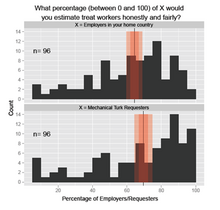
A sweatshop or sweat factory is a crowded workplace with very poor, illegal working conditions. The manual workers are poorly paid, work long hours, and experience poor working conditions. Some illegal working conditions include poor ventilation, little to no breaks, inadequate work space, insufficient lighting, or uncomfortably/dangerously high or low temperatures. The work may be difficult, tiresome, dangerous, climatically challenging, or underpaid. Workers in sweatshops may work long hours with unfair wages, regardless of laws mandating overtime pay or a minimum wage; child labor laws may also be violated. Women make up 85 to 90% of sweatshop workers and may be forced by employers to take birth control and routine pregnancy tests to avoid supporting maternity leave or providing health benefits. The Fair Labor Association's "2006 Annual Public Report" inspected factories for FLA compliance in 18 countries including Bangladesh, El Salvador, Colombia, Guatemala, Malaysia, Thailand, Tunisia, Turkey, China, India, Vietnam, Honduras, Indonesia, Brazil, Mexico, and the US. The U.S. Department of Labor's "2015 Findings on the Worst Forms of Child Labor" found that "18 countries did not meet the International Labour Organization's recommendation for an adequate number of inspectors."
Employment is a relationship between two parties regulating the provision of paid labour services. Usually based on a contract, one party, the employer, which might be a corporation, a not-for-profit organization, a co-operative, or any other entity, pays the other, the employee, in return for carrying out assigned work. Employees work in return for wages, which can be paid on the basis of an hourly rate, by piecework or an annual salary, depending on the type of work an employee does, the prevailing conditions of the sector and the bargaining power between the parties. Employees in some sectors may receive gratuities, bonus payments or stock options. In some types of employment, employees may receive benefits in addition to payment. Benefits may include health insurance, housing, disability insurance. Employment is typically governed by employment laws, organisation or legal contracts.
Freelance, freelancer, or freelance worker, are terms commonly used for a person who is self-employed and not necessarily committed to a particular employer long-term. Freelance workers are sometimes represented by a company or a temporary agency that resells freelance labor to clients; others work independently or use professional associations or websites to get work.

Piece work or piecework is any type of employment in which a worker is paid a fixed piece rate for each unit produced or action performed, regardless of time.
Amazon Mechanical Turk (MTurk) is a crowdsourcing website with which businesses can hire remotely located "crowdworkers" to perform discrete on-demand tasks that computers are currently unable to do as economically. It is operated under Amazon Web Services, and is owned by Amazon. Employers post jobs known as Human Intelligence Tasks (HITs), such as identifying specific content in an image or video, writing product descriptions, or answering survey questions. Workers, colloquially known as Turkers or crowdworkers, browse among existing jobs and complete them in exchange for a fee set by the employer. To place jobs, the requesting programs use an open application programming interface (API), or the more limited MTurk Requester site. As of April 2019, Requesters could register from 49 approved countries.
Human-based computation (HBC), human-assisted computation, ubiquitous human computing or distributed thinking is a computer science technique in which a machine performs its function by outsourcing certain steps to humans, usually as microwork. This approach uses differences in abilities and alternative costs between humans and computer agents to achieve symbiotic human–computer interaction. For computationally difficult tasks such as image recognition, human-based computation plays a central role in training Deep Learning-based Artificial Intelligence systems. In this case, human-based computation has been referred to as human-aided artificial intelligence.

Crowdsourcing involves a large group of dispersed participants contributing or producing goods or services—including ideas, votes, micro-tasks, and finances—for payment or as volunteers. Contemporary crowdsourcing often involves digital platforms to attract and divide work between participants to achieve a cumulative result. Crowdsourcing is not limited to online activity, however, and there are various historical examples of crowdsourcing. The word crowdsourcing is a portmanteau of "crowd" and "outsourcing". In contrast to outsourcing, crowdsourcing usually involves less specific and more public groups of participants.
An online marketplace is a type of e-commerce website where product or service information is provided by multiple third parties. Online marketplaces are the primary type of multichannel ecommerce and can be a way to streamline the production process.

Figure Eight was a human-in-the-loop machine learning and artificial intelligence company based in San Francisco.

Samasource Impact Sourcing, Inc., formerly known as Samasource and Sama, is a training-data company, focusing on annotating data for artificial intelligence algorithms. The company offers image, video, and sensor data annotation and validation for machine learning algorithms in industries including automotive, navigation, augmented reality, virtual reality, biotechnology, agriculture, manufacturing, and e-commerce. Sama's mission is to expand opportunity for low-income individuals through the digital economy. One of the first organizations to engage in impact sourcing, Sama trains workers in basic computer skills and pays a local living wage for their labor.

Leila Janah was an American businesswoman. She was the founder and CEO of Sama and LXMI. Sama's 11,000 employees have worked under contracts with companies including Microsoft, Google, Facebook, Walmart, Getty Images, Glassdoor and Vulcan Capital.
Micro-volunteering describes a volunteer, or team of volunteers, completing small tasks that make up a larger project. These tasks often benefit a research, charitable, or non-governmental organization. It differs from normal volunteerism as the tasks take only minutes to a few hours, and the volunteer does not make a long-term commitment. As a form of virtual volunteering, the tasks are usually distributed and completed online via an internet-connected device, including smartphones. It typically does not require an application process, screening or training period, takes only minutes or a few hours to complete, and does not require an ongoing commitment by the volunteer.
Macrotasking is a type of crowdsourcing that is distinct from microtasking. Macrotasks typically have the following characteristics:
Government crowdsourcing is a form of crowdsourcing employed by governments to better leverage their constituents' collective knowledge and experience. It has tended to take the form of public feedback, project development, or petitions in the past, but has grown to include public drafting of bills and constitutions, among other things. This form of public involvement in the governing process differs from older systems of popular action, from town halls to referendums, in that it is primarily conducted online or through a similar IT medium.
Digital labor or digital labour represents an emergent form of labor characterized by the production of value through interaction with information and communication technologies such as digital platforms or artificial intelligence. Examples of digital labor include on-demand platforms, micro-working, and user-generated data for digital platforms such as social media. Digital labor describes work that encompasses a variety of online tasks. If a country has the structure to maintain a digital economy, digital labor can generate income for individuals without the limitations of physical barriers.
Playment is an Indian data labeling platform which helps machine learning engineers build high quality ground truth datasets for training and validating machine learning models. It breaks down large problems into micro-tasks and distributes among its large community of trained annotators. It works on the principle of microwork, where a series of small tasks which together comprise a large unified project, and are completed by many people over the Internet.
Disaggregated work is a work divided into its elemental activities, which can be reassembled using alternative solutions, for example by automating some of the activities and getting rid of or changing other activities. The concept can be applied on the scale of an individual, a department, a company, or an entire industry. During the industrial revolution, disaggregation often entailed replacing tradespeople such as blacksmiths, carpenters, and weavers with steam-powered machines operated by unskilled laborers.

Gig workers are independent contractors, online platform workers, contract firm workers, on-call workers, and temporary workers. Gig workers enter into formal agreements with on-demand companies to provide services to the company's clients.
Ghost work is work performed by a human, but believed by a customer to be performed by an automated process. The term was coined by anthropologist Mary L. Gray and computer scientist Siddharth Suri in their 2019 book, Ghost Work: How to Stop Silicon Valley from Building a New Global Underclass.







